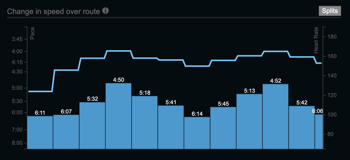Different running sessions for less boring runs
Whether or not you're a runner, you've probably heard many times "Running? Man
that's boring!".
Let's review how you can prove that wrong!
Disclaimer
This article is just based on my own experience, and is by no means something to follow blindly. Trust your own judgment, as you always should: some activities are OK for most people, but could be dangerous for others, due to many reasons (health, medical past, ...).
Approach
Take it easy
As I hinted in the disclaimer above: each runner is unique - don't try to run 20K if you just started running, or haven't run in years. Take it easy, doing too much all of a sudden will likely lead to an injury.
When shall I run?
Again, this is very different from one person to another.
Personnally, I'm more an early bird and like running early/in the morning, but
depending on my agenda, I can also run at lunch time, in the afternoon or in the
evening.
Of course if you're working remotely, this is fine - but if you're working in an
office, this is a bit different, as you'll need a place to shower after your run
;)
Also, try to plan a bit ahead - the day before is OK - not having a plan is the
best way to skip one, then two days, then a whole week.
Just the fact of having "decided" that you'll run tomorrow morning between 7 and
8am will (most of the time) make it happen!
Diversity is key
You'll see below that I have divided the sessions in 4 types.
Depending on how often you run, you'll want to mix those sessions.
Also, try avoiding running the same route again and again, as it's the best way to actually get bored and stop enjoying running.
And of course, this is perfectly fine to match two types together! Sometimes I will perform a long run as 1K intervals for instance.
#1: Easy Runs
You've probably read that a lot: in order to progress in running, you must practive fundamental endurance on a regular basis. And I mean, like a lot: 60 to 70% of your runs should be ran at this pace - put simply, this is a pace where you can comfortably talk with someone else.
Fundamental endurance basically allows being stronger, faster and more enduring
... and it also avoids injuries - if you workout too hard and only do workout
sessions, this will likely lead to an injury, as your body is over stressed.
Fundamental endurance allows recovering from those stressful sessions.
The trap to avoid is to increase your speed because you feel you're too slow - NO! Easy runs must be run at < 75% of your maximum heart rate - e.g. 135 if your maximum is 180 BPM.
#2: Workouts
Workouts are not everyone's preferred sessions, but hey they're the ones who make you progress, as they're stressing your body - who then needs rest and easy runs to "absorb".
Loops
When thinking about a loop, you'll probably think about a track, and yep you're
certainly right, that's what most runners will use.
However this only works if you live in a city or can/want to drive to this
track.
Personnally, I like going out for a run without riding/driving, and living in
the countryside, there's not much track options. But that doesn't prevent me
from running loops! I have woods with trails, so finding a loop is easy:

The above map shows a loop I ran the other day - all you need is something than you can do several times. You can tweak the distance (this loop does ~1.3 Kms) to your preference, depending on how many loops you want to run.
As with any workout, it is recommended to run 10 to 20 min at an easy pace, to warm you up, and then cool down for the same amount of time.
Hill Repeats
Another typical workout session: running uphill several times fast / as fast as you can - making it a cardio exercise.
You don't necessarily have to use a steep hill: the one I'm typically using has an elevation of ~10 meters (see screenshot below), and is ~300 meters long - I run it 8 to 10 times, depending on my session.

Of course if you do have a steep hill that you can use, just do it :)
Also, you can introduce diversity by running short hill repeats one time (e.g. 200 meters), and doing longer ones another time (e.g. 400 to 500 meters).
Downhill Repeats
A variation from the previous one: rather than running uphill, you run fast
going downhill, and slow when going uphill.
The interest is to master your speed and improve how you place your feet when
going downhill - which can prove useful for race day!
Intervals
Interval running is yet another "classical" session, but I still like it as you
have many different ways to run them.
The idea here is to run slowly, then fast, then slow again, etc - again to build
resistance.
- Distance: there's more than "1K Intervals!". You can do 500m intervals,
shorter or longer.
Also, distance for recovering doesn't have to match the steady pace one: you can run fast for 1K, and recover for 500m if you want. - Time: instead of running fast for e.g. 1K, you do it for 2, 3, 5, 10 minutes. Then recover for 1, 2, 5 min...
- Pyramid Intervals: as the name suggests, the intervals are run in pyramid, i.e. increasing pace, then decreasing it. You can run either a "big pyramid", or several smaller ones, like below:

Fartlek
Fartlek (Swedish for "speed play") is a type of interval training, but since it's really "unstructured", I preferred having it in a dedicated section.
When running a Fartlek session, you will mix periods of fast and slow running, which could be "sprint/jogging", or "walk/jogging" depending on your skills/desire.
I like Fartlek sessions because they're fun to run: no plan, you just decide "as you go" when switching from jogging to sprint: next telephone pole, next turn, next tree, ... It's really up to you to decide.
Fartlek provides the same interest as other interval training: cardio exercise.
#3: Long Runs
Yes, long runs are good and needed to build resistance.
No, you don't have to run them every single Sunday! :D
What is a long run? It's typically a session longer than your average runs,
meaning it can be very different from one person to another!
For me, a long run is at least 1h30, because the minimum distance I'm
running is 10K, i.e. 50 to 60 minutes.
But for a beginner runner who runs 5k twice a week, a long run would be 45 to 50
minutes - again, it's a matter of your own habits.
I like long runs as they allow exploring a bit / much more than your usual
surroundings, and that's even better if you do this long run in a city/area you
don't know.
I will typically plan my long runs by drawing my route upfront (see this
article I wrote about applications doing that).
#4: Others
Run Like You Feel
The rule is simple: no goal, no pace target, no limit.
Want to run like a snail? Fine. Fast like you've never been? Also fine. Started
easy but feel your legs are on fire today? Go for it!
That's one of the sessions I enjoy the most: you never know what you're gonna do, and even planning for it does not happen! Usually, I run such a session on an "Easy Run" day.
The "Wanderer" session
(Not sure the name is nice, but that's all I could came up with).
The goal here is to run and make turns when you decide so. This forces you to take new paths and hence (hopefully) enjoy your running session a bit more, and possibly discover unknown areas.
Of course this means that you need flexibility in your schedule, as getting lost may happen, so if you only have say 45 min to run, maybe that's not something you want to try at that time :)
Wrap Up
I hope this article showed you that running does not have to be boring!
If you think I forgot some possibilities, please let me know on
Twitter.
Tags: Running